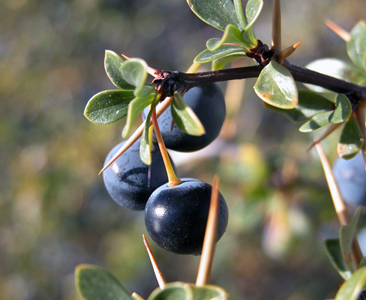The legend of the calafate See map
Ñires, lengas and coihues forests begin to make a characteristic tone, announcing the fall and giving the trees a colorful range, from deep red through shades from gold to orange. This transformation has been repeated year after year, since time immemorial.
The tehuelches lived in this landscape. They are the original owners of the land, who at the onset of winter began to emigrate walking north, where the cold was not so intense and the hunting wasn't missing.
 El calafate, typical bush in Patagonia. Photo courtesy of Rogerio Mathias from patagonia.com.ar album
El calafate, typical bush in Patagonia. Photo courtesy of Rogerio Mathias from patagonia.com.ar albumIn connection with this migration tradition in Patagonia preservs a legend. It is said that once Koonex, the old woman from a tribe of tehuelches, could no longer walk because their tired old legs were exhausted, but the time could not stop. So Koonex understood the natural law of destiny. The women of the tribe made a guanaco-skin tent and gathered much wood and food to leave with the old woman, saying goodbye to her with the song of the family.
Koonex, back home fixed his tired eyes in the distance, until the people of his tribe was lost after the edge of a plateau. She was left alone to die. All living creatures were going away and began to feel the heavy slumber and enveloping silence.
The multicolored sky was slowly dying. Many suns and many moons passed by until the arrival of spring. Then the shoots were born, arrived swallows, plovers, happy chingolos and the chattering parrots. Life again.
On Koonex tent landed a flock of little birds singing happily. Suddenly the voice of the old woman was heard who, from inside the tent was scolding them for leaving her alone during the long, harsh winter.
After the surprise a "chingolito" replied, "we went away in the fall because the food becomes scarce. Also during the winter we have no place to take shelter." "I understand you," replied Koonex, "so, from now on you will have food in autumn and good coat in winter and I'll never be alone" and then the old woman was silent.
When a gust suddenly turned the skins of the tent instead of Koonex there was a beautiful thorny bush of fragrant yellow flowers. By mid summer the delicate flowers became fruits and before the fall began to mature taking a blue color of exquisite taste and high nutritional value. From that day on some birds did not migrate more and those who were gone, hearing the news, returned to try the new fruit.
Tehuelches also tried it, adopting it forever. Seeds scattered throughout the region and, thereafter, "who eats Calafate, always returns".
Viajes por la Patagonia
Related Articles
© Patagonia.com.ar 2025 | Todos los derechos reservados.
